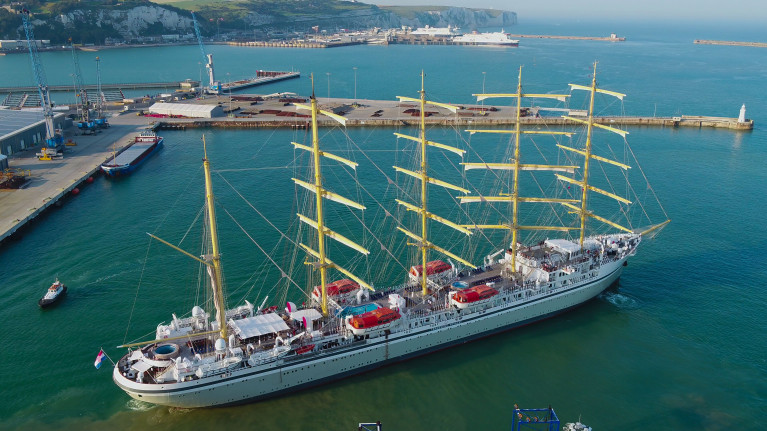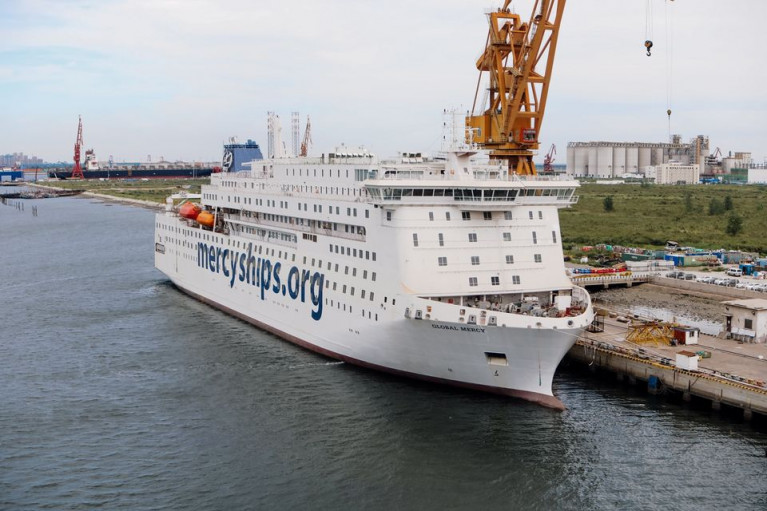Displaying items by tag: World's Largest
World's Most Powerful Sailing Cargo Ship Welcomed to Isle of Man Ship Registry (IOMSR) Fleet
The world’s most powerful sailing cargo ship has gone into service under the Isle of Man flag.
Berge Olympus, a pionering bulker was officially unveiled in October after its retrofit by Berge Bulk, one of the world’s leading dry bulk ship-owners.
Four WindWings have been installed on the Newcastlemax bulker as part of Berge Bulk’s ambition to become carbon neutral by 2025. The cutting-edge technology uses wind power to reduce fuel and emissions.
In addition, Berge Olympus has been retrofitted with a shaft generator system. The shaft generator is driven by the main engine to supply electric power to the vessel, also saving fuel and reducing emissions.
The Isle of Man Ship Registry (IOMSR) participation in the projects is a testament of shared vision with Berge Bulk as one to lead the industry to a zero-carbon future through safe, efficient, and sustainable shipping.
And the IOMSR’s Singapore representative Captain Raja Ray was one of the first on board to see the new technology first-hand following the retrofit.
He said: “I inspected the vessel last year before its retrofit and returning on board, the transformation and the technology behind it that I saw was truly amazing.
“Berge Olympus holds a bold vision for the future, serving a testament to both innovation and sustainability.
“We are very proud that the Berge Olympus is part of the IOMSR fleet and that we are able to support Berge Bulk in its future ambitions as we both work together in leading the industry on its journey to net zero.”
The IOMSR flagged Berge Olympus will sail between Brazil and China - a trade route known for having favourable wind conditions.
Its WindWings are large, rigid sails that can be adjusted to optimise the aerodynamic performance of the ship. Each of the four WindWings is 20m wide and 37.5m tall, which is taller than a 10-story building.
The WindWings can save up to 20 per cent fuel consumption, and corresponding CO2 emissions on an average worldwide route.
Starting out with 12 vessels in 2007, the company now owns, operates and manages a fleet of 85 safe and fuel-efficient vessels, equating to 14 million DWT.
Cameron Mitchell, IOMSR director, said: “Berge Bulk’s WindWings project stands as testament to its commitment to lead the way towards a zero-carbon future while enhancing vessel efficiency.
“The initiative aligns with the new IMO goals, to reach net-zero GHG emissions from international shipping by or around 2050, goals which IOMSR is also fully committed to, through our industry leading work.
“We look forward to continuing our partnership with Berge Bulk as it works towards its sustainability aims.
“The project also highlights that there are clear opportunities for vessel owners to swiftly retrofit new technologies to make a rapid and profound difference to the climate impact of their fleet.”
IOMSR believes the maritime industry has a collective responsibility to respond to the climate emergency.
To that end it became the first flag state to join the Getting to Zero Coalition, an industry-led alliance working towards decarbonising the international maritime shipping sector.
It is a partnership between the Global Maritime Forum, the Friends of Ocean Action and the World Economic Forum. Members include more than 120 organisations from the maritime, energy, infrastructure and finance sectors
In another industry leading development, in April 2022 IOMSR become the first flag state in the world to reduce registration fees for ships deploying green technology.
The measure gives ship owners a 15 per cent reduction on their annual registration fee. The reduced fee is available to operators of cargo ships, commercial yachts or passenger ships which are investing in biofuel, alternative fuels, wind, or shore-side energy technology.
IOMSR is one of the world’s leading flag states and is ranked 18 in the world by Clarkson’s with around 300 ships and 12.5m GT under its flag. The registry has held top spot on the Paris MoU Port State Control whitelist and is on the whitelist in the Tokyo MoU rankings.
The registry is headquartered in Douglas, Isle of Man, a self-governing British Crown dependency and is a Category One member of the Red Ensign group.
World's Largest Cruise Tallship, Golden Horizon Calls to Port of Dover For Inaugural Call
The World's largest square-rigged sailing vessel, the brand new cruise tallship Golden Horizon in mid-July sailed into the Port of Dover; the ship's departure port for four new UK voyages throughout this month.
The Golden Horizon, a near replica of the 1913 built tallship France II, operates for Tradewind Voyages which deployed their newbuild to the cruise and ferryport with the lastest departure from the English south-east port having taken place last week.
Sonia Limbrick, Head of Cruise at the Port of Dover said: “We offer a very warm welcome to the beautiful Golden Horizon here in Dover today (15 July), what an extraordinary ship she is! I hope our local community makes the most of the rare opportunity to see her before she departs for four cruises throughout July.
I’m really pleased to see the cruise season back in full swing again; it’s exciting to see another new cruise line at the Port, both for the first time in Dover and as she prepares to embark on her first ever voyages.”
The call marks the third passenger cruise call in just under three weeks to depart from the Port of Dover since its cruise season re-launch on 26th June. The Port’s cruise team has been working hard on COVID safe measures to help protect visiting cruise lines, their crew and passengers. For further information visit here.
After the inaugural call, Golden Horizon at this stage will make a final departure from the Kent port scheduled to take place on 31st July.
World's Largest Charity Hospital 'Mercy' Ship Sails to Africa in 2021 (Volunteers Required & Ashore)
The World's largest and newest charity hospital ship operated by Mercy Ships announced plans to sail to Africa in late 2021 under the name of Global Mercy.
Mercy Ships, a faith-based global organisation powered by charitable donors and volunteers, has been providing world-class surgical care to those in need for more than 40 years, free of charge.
“The Global Mercy will be a true modern marvel— a fully custom-built hospital ship with customised instruments, state-of-the-art technology and highly-trained talent of a modern hospital,” said Rosa Whitaker, President of Mercy Ships. “It also represents a unique call-to-action for anyone called to serve, and it presents the opportunity for people to use their skillset to positively impact global healthcare.”
Each year, 18.6 million people die due to lack of access to surgical care, 93 per cent of whom stem from Africa. As COVID-19 threatens the stability of already fragile healthcare systems globally, the need to provide basic life-saving care is greater than ever, especially in low-to-middle income countries. The Global Mercy will deliver a safe and clean environment to various African nations, providing help and resources from some of the most well-trained physicians in the world. Over the vessel’s 50 year expected lifespan, it is estimated that more than 150,000 lives will be changed onboard through surgery alone.
In addition to providing surgeries, the Global Mercy will be outfitted with state-of-the-art training spaces including a simulation lab with virtual and augmented reality, mannequins and other training tools and simulated post-op care space, which allow trainers to simulate local conditions and limitations to teach best practices in low-resource environments.
The 174-meter, 37,000-ton ship will have six operating rooms and house over 600 volunteers from around the globe representing many disciplines including surgeons, maritime crew, cooks, teachers, electricians, the host staff and more. The ship will also feature a 682-seat auditorium, student academy, gymnasium, pool, café, shop and library – all of which have been designed to accommodate up to 950 crew onboard when docked in port.
The Global Mercy will join the current flagship Africa Mercy, more than doubling the impact of volunteers and services provided by the charity. For more information about Mercy Ships, updates on Global Mercy or how to volunteer or donate, please visit: www.mercyships.org.uk
Volunteers Sought
Afloat adds Mercy Ships are looking for volunteers. In order to double Mercy Ships impact for Africa’s healthcare systems, we need to double our crew. As the new Global Mercy and the Africa Mercy prepare to set sail, we're looking for maritime & technical professionals to join us onboard. There are also land based positions. For further information visit here.






























































